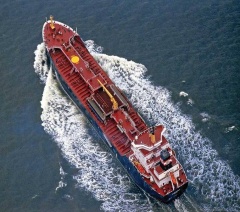Petroleum and Petroleum Products
| Infobox on Petroleum and Petroleum Products | |
|---|---|
| Example of Petroleum and Petroleum Products |  |
| Facts | |
| Origin | See text |
| Stowage factor (in m3/t) | Petr. oil 1,34 m3/t (bulk) Petr. oil 1,4 m3/t (drum) |
| Humidity / moisture | |
| Ventilation | |
| Risk factors | |
Petroleum and Petroleum Products
Description
Petroleum products are materials derived from crude oil processed in oil refineries. This includes various grades of fuel oil and gasoline, but also blends to give for instance gasoline, jet fuel, diesel fuel, heating oil, lubrication oils. Heavier fractions can also be used for the production of asphalt, wax, tar, etc. When carried in liquid form in bulk, these products are liable to damage by contamination and by loss of volume.
Contamination may occur by way of the remains of a previous cargo or by tank cleaning substances, as a result of improperly cleaned tank and/or pipelines.
Damage may also occur through chemical changes in the product itself, brought about by contact with coatings on tank walls and pipelines, or by contamination by moisture or sea water.
Liable to loss in volume as a result of incomplete emptying of tanks and pipelines. The amount of loss will depend on the properties of the product, the dimensions and design of the cargo tanks, and the efficiency of the ship’s discharge system. Characteristics of the product which influence its retention on board are its adhesive properties and viscosity, and the presence of non-homogeneous components in the cargo such as wax, sediment and water.
Retention will also be related to the composition of the tank wall and the temperature at the time of discharge. To assess the risks associated with the transport of bulk liquids a great deal of information is required on the product itself and the mode of transport to be used. In order to avoid loss the shipper should provide an exact definition of the product to be carried in order that the correct pre-shipment measures may be carried out. All loading and unloading procedures should involve the monitoring of selected, critical, quality parameters of the product throughout the operation.
Description of the methods used in measuring temperatures and taking samples should be provided, and made available for consideration in any assessment of cause of damage.
See also Lubricating Oils and Paraffin.
Full information on this product is in the process of completion.











